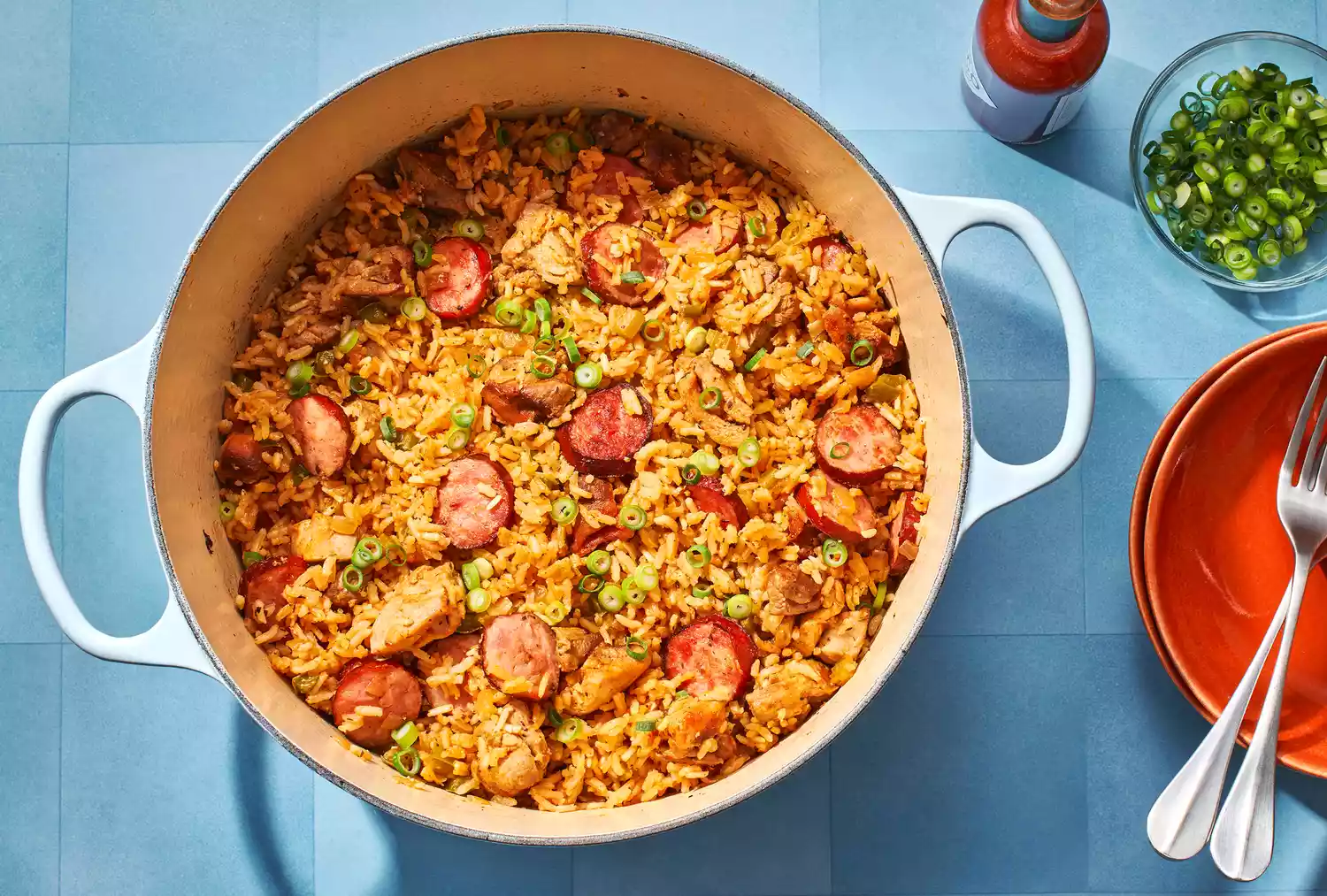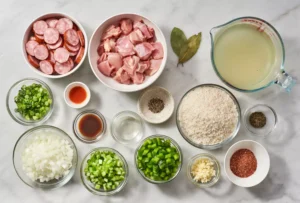The traditional Cajun-style jambalaya is the kind that I appreciate the most, despite the fact that I am a native of Louisiana and have consumed and prepared jambalaya in a myriad of different ways throughout the years. Your time and effort will go a long way in this dish because it is one of those dishes that is sure to please a large number of people. In addition, if you are not feeding a large gathering, jambalaya will provide you with a substantial amount of leftovers that you may enjoy throughout the week.
Although there is some preparation work needed in making this jambalaya, such as slicing vegetables and frying the chicken and sausage, once those preparations are finished, everything comes together in one pot in a relatively short amount of time.
Southern Louisiana is the birthplace of jambalaya, a robust dish that may be prepared in a single pot. It is believed that the first people to prepare this dish were enslaved people from Western and Central Africa. They used Native American red rice that had been carried to the Americas from places that had been colonized. In order to prepare this mouthwatering feast, these chefs would make use of the meats, veggies, and spices that were at their disposal.
The flavor of jambalaya can sometimes be compared to that of gumbo; nevertheless, jambalaya is distinct from gumbo in terms of its texture and the cooking methods that are utilized. Gumbo is often a sauce that is spooned over rice, whereas jambalaya is more similar to paella in that the rice is cooked in the same pot as the broth and other ingredients, which soak up the majority of the liquid. Recipes for jambalaya can also be slightly different depending on whether they are of Creole or Cajun provenance historically. This recipe for Cajun jambalaya will teach you how to create it, as well as the differences between the two.
An Overview of Jambalaya’s History
Jambalaya is a food that originated in Louisiana, where African and European cuisines played a significant part in the development of many of the state’s traditional dishes, such as gumbo and jambalaya, in which rice plays a significant role. It is possible to trace the origins of jambalaya back to Spanish paella, which was most likely derived from African rice meals. This is because Muslim North Africans introduced rice to Spain, which is where jambalaya was first created. And although there are numerous versions of jambalaya that can be found throughout the state of Louisiana in the present day, the most frequent types are Cajun and Creole, which are regionally specific and differ in the ingredients that are most commonly used.
The Difference Between Cajun and Creole Jambalaya
The addition of ingredients that are typical of bayou parishes, which are counties that are located along the low-lying banks of the Mississippi River, is what gives a jambalaya its distinctively Cajun flavor. These settlements were mostly made up of farmers who were members of the working class and had access to a variety of products, including andouille sausage, poultry or wild game, rice, oil, and the holy trinity vegetables, which included onions, celery, and green bell pepper.
Jambalaya is a dish that is commonly found in towns in and around the New Orleans area that were more inspired by Spanish and French cuisine. This dish is characterized by the presence of tomatoes, seafood, and butter. Creole food is easily identifiable by the presence of these certain items. Additionally, in comparison to its Cajun cousins, Creole jambalaya is more moist in texture, resembling the consistency of a European paella.
What’s the Difference Between Gumbo and Jambalaya?
A key distinction between jambalaya and gumbo is the amount of rice that is used in each dish. When making jambalaya, rice serves as the foundation, and it is combined with vegetables, sausage, and chicken to create a dish that is similar to fried rice. Rice is typically served on the side of the main roux-based soup that is contained in gumbo. Additionally, a roux is not necessary for the preparation of jambalaya, although gumbo is.
Traditional Ingredients for Jambalaya
There are a few distinct components that distinguish jambalaya from other rice meals that are common in the region.
- Meat: When making jambalaya, meat, seafood, or a combination of the two are usually typically used as preparation methods. When utilizing meat, chicken, pork, and sausage are frequently included, whereas shrimp, crab, and crawfish are examples of classic seafood selections. By utilizing bite-sized portions of chicken thighs and slices of spicy Andouille sausage, our dish places a significant emphasis on the content of meat.
- Vegetables: It is likely that you are aware with mirepoix, which is a traditional French dish consisting of onions, carrots, and celery that serves as the foundation for a variety of French cuisines. It is nearly always the case that the “holy trinity,” which is comprised of onion, celery, and bell pepper, is utilized in the preparation of jambalaya, which is popular in both Cajun and Creole cuisines. To begin the process of flavor development in this dish, these aromatics and veggies are what are used.
- Spices: Jambalaya is a dish that is made using a variety of ingredients, and each household and region has its unique recipe for making it. Paprika, cayenne pepper, dried oregano, and dried thyme are the ingredients that are utilized in our special recipe. The smokiness is contributed by paprika, the spiciness is contributed by cayenne, and the earthy freshness is contributed by the dried herbs.
- Rice: The white rice with long grains is the type that we recommend. It is possible that the rice will become somewhat mushy if you use a rice with shorter grains.
Tips for Making Jambalaya
- Use long-grain rice – When making jambalaya, it is important to use long-grain rice since it has a more fluffy texture and separates neatly during the cooking process. Short-grain rice, on the other hand, is more starchy and tends to cling together.
- Rinse rice beforehand – My recommendation is to always pre-rinse uncooked rice before cooking it until the water becomes clear. This will help remove any excess starches that may be present in long-grain rice.
- Andouille sausage is ideal, but an alternate will do – You will be able to get Andouille at most large grocery stores, such as Sprouts and Walmart, and it has a smokey flavor that is uniquely Louisianan. You have the option of substituting Andouille with another type of smoky sausage, if you so want.
- Serve hot sauce on the side – There is a wide range of vinegar profiles among hot sauces; therefore, the majority of Louisianans serve hot sauce on the side so that individuals can add as much or as little as they choose.
- Make Ahead – Before cooking, vegetables can be chopped, and meats can be browned at the beginning. Put the ingredients in the refrigerator until you are ready to begin assembling the jambalaya.
Ingredients
- 1 pound boneless, skinless chicken thighs, cut into 1-inch pieces
- 4 teaspoons Cajun seasoning with salt, divided, or 3 teaspoons salt-free Cajun seasoning mixed with 1 teaspoon fine salt
- 2 teaspoons neutral oil, such as canola
- 12 ounces andouille or smoked sausage, cut into 1/4-inch thick coins
- 1 cup diced yellow onion
- 1 cup diced green bell pepper
- 1/2 cup diced celery
- 4 large cloves garlic, minced
- 2 cups long-grain white rice, rinsed until water runs clear and drained
- 2 teaspoons Worcestershire sauce
- 2 dried bay leaves
- 1 teaspoon dried thyme
- 1/2 teaspoon freshly ground black pepper
- 3 cups low-sodium chicken broth
- 4 medium scallions, thinly sliced
- Tabasco sauce, for serving
Steps to Make It
- Step 1: Combine the chicken thighs with two teaspoons of the Cajun seasoning in a medium bowl. If you are using salt-free seasoning, add half a teaspoon of salt to the mixture as well. Toss the chicken thighs to ensure that they are coated.
- Step 2: In a large Dutch oven or other heavy-duty pot, bring the oil to a medium-high medium temperature. Add the chicken and cook it for eight to ten minutes, browning it on all sides. Place the contents on a platter and set them away.
- Step 3: Place the sausage in the pot and cook it for around five minutes, or until it has browned and the fat has rendered. Move the chicken to the same platter as the other ingredients.
- Step 4: Make sure to include the celery, onion, and bell pepper in the saucepan. Cook over medium heat for five to six minutes, or until the vegetables are soft and transparent.
- Step 5: Garlic, rice, Worcestershire sauce, bay leaves, thyme, black pepper, chicken broth, and the remaining two teaspoons of Cajun seasoning should be added. If you are using salt-free seasoning, add the remaining half teaspoon of salt. Return the chicken and sausage to the pot and stir to combine. In order to mix, stir. Place over high heat and bring to a boil.
- Step 6: Once the rice is fully cooked and can be fluffed with a fork, approximately thirty minutes after the rice has been cooked, reduce the heat to low and simmer the rice while covering it. In order to remove any excess moisture from the rice, continue cooking it uncovered for an additional five to ten minutes if it is still too wet.
- Step 7: This dish should be served with the scallions and spicy sauce on the side as garnishes.
Cajun Jambalaya FAQ
1.What is jambalaya seasoning?
- Seasonings for Creole and Cajun jambalaya typically differ slightly from one another; nevertheless, practically every spice blend will include paprika, cayenne, and a combination of dry herbs such as oregano, basil, rosemary, thyme, and bay on the list of ingredients.
2. Does real jambalaya have tomatoes?
- To add moisture to the meal, Creole jambalaya makes use of tomatoes, which results in the rice having a somewhat more soupy consistency. Both versions of Cajun jambalaya are genuine and authentic, despite the fact that tomatoes are not customarily included in either version.
3. Should jambalaya be thick or soupy?
- Jambalaya should be prepared in the same manner as any other dish consisting of meat and rice that would be prepared in a braiser or skillet. It is important that the rice be moist, but there should not be an excessive amount of moisture as well.
4. Why is my jambalaya rice mushy?
- There are occasions when rice with grains that are too short can absorb the liquid too rapidly, resulting in the rice becoming mushy. The use of long-grain rice, such as basmati or jasmine, is that which we advocate.



